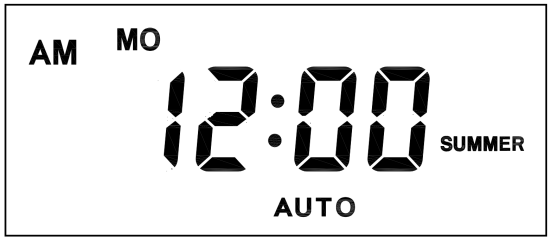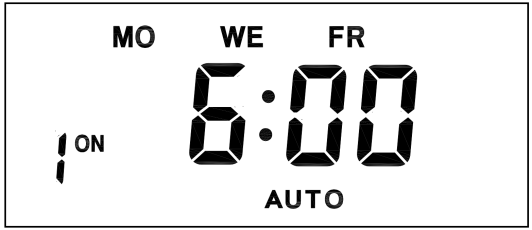Instruction Manual
1. Features
Clock display, 10 sets of adjustable timed power control, randomized power control, manual switch and optional DST setup.
2. First time charging
This timer contains a rechargeable battery. It is normal that the new/old model runs out of battery if it wasn`t being charged for a long period of time. In this case, the screen will not turn on.
To charge : simply plug the timer to a power outlet. The charging time should take at least 15 minutes.
If the screen doesn`t light up or displays garbled characters, simply reboot the system by pressing the [RESET" button.
3. Set clock
Hold [CLOCK" button and [WEEK" button to adjust week.
Hold [CLOCK" button and [HOUR" button to adjust hour.
Hold [CLOCK" button and [MINUTE" button to adjust minute.
Hold [CLOCK" button and [TIMER" button to select 12 hour/24 hour display.
Hold [CLOCK" button and [ON/AUTO/OFF" button to enable/disable DST (daylight-saving-time).
4. Set timer
Press [TIMER" button, select and set timer. Setting rotation : 1on, 1off, 2on, 2off, ...... , 10on, 10off.
Press [HOUR" button to set hour for timer.
Press [MIN" button to set minute for timer.
Press [WEEK" button to set weekday for timer. Multiple weekdays can be selected. ex: if selected [MO", the timer will only apply on every Monday; if selected [ MO, WE, FR", the timer will apply on every Monday, Wednesday and Friday.
Press [RES/RCL" button to cancel the selected on or off timer. The screen will show "-- -- : -- --" , the timer is canceled.
Press [RES/RCL" button again to reactivate the timer.
When timers are set, press [CLOCK" to quit timer setting and return to clock.
5. Random function
Press [RANDOM" button to activate random function, press again to cancel function.
System only runs random function when [AUTO" is on.
Random function will automatically start the timer from 2 to 32 minutes after the setting.
ex : if timer 1on was set to 19:30 with the random function on, the timer will activate randomly between 19:33 to 20:03.
if timer 1off was set to 23:00 with the random function on, the timer will activate randomly between 23:02 to 23:32.
To avoid overlapping, make sure to leave a minimum of 31 minutes gap between different sets of timer.
6. Manual control
Displayed features:
ON : socket turns on.
OFF : socket turns off.
AUTO : socket turns on/off automatically via timer.
Manual ON setting
Press [ON/AUTO/OFF" button to switch from [AUTO" to [ON".
This mode allows socket of the device to power up. Power indicator will light up.
Manual OFF setting
Press [ON/AUTO/OFF" button to switch from [AUTO" to [OFF".
This mode turns socket of the device off. Power indicators will turn off.
7. Electrical parameters
Operating voltage : 230VAC
Battery : NiMh 1.2V
Power consumption : < 0.9W
Response time : 1 minute
Power output : 230VAC/16A/3680W
Q&A
Q: Why won`t my timer turn on?
A: It`s out of battery, you can charge the timer by plugging onto any power outlet. Charge the device for at least 15 minutes. Then press [RESET " button to reset the device.
Q: Can I set seconds of the timer?
A: No, the smallest time unit is minute.
Q: Does my timer keeps old settings without being plugged onto a power outlet?
A: Yes, the timer has an internal battery, it allows the timer to save settings without a power outlet.
Q: Is the battery rechargeable?
A: Yes, the battery is rechargeable. We recommend to charge it for 4 hours so the battery is fully charged.
Q: Does the timer needs internet connection?
A: The timer does not need internet.
Q: Does the screen have back light function?
A: It doesn`t support back light.
Digital Timer Socket, Timing Switch Socket, Electronic Timer Socket, Timer Socket NINGBO COWELL ELECTRONICS & TECHNOLOGY CO., LTD , https://www.cowellsockets.com
Global panel demand is sluggish. Panelists are busy coping with 2011. Global flat-panel display manufacturers have fallen into sluggish demand and prices and profits have fallen rapidly. Especially in LCD TV panels, prices have fallen for 17 consecutive months. Some flat-panel display manufacturers It is also shifting the production capacity of large-size LCD TV screens to the production of screens for small-sized mobile terminals. The LCD panels that are in a haze have seen price increases since the end of 2011 to the beginning of 2012. The LCD panel industry is not optimistic. In 2012, the trend of the LCD panel market became the focus of attention of the entire industry. According to data, Chinese TV brands shipped 4.219 million LCD TVs in November, which was 19.5% higher month-on-month, and panel purchases reached 4.449 million, an increase of 32.9% from the previous month, both driven by demand from New Year's Day and the Spring Festival season. Expected in the market previously. Chimei, AUO, and BOE TV panels all showed strong market explosiveness.
In 2012, to stimulate market demand, panel makers continued to optimize panel technology development and cost reduction, and expanded shipments by developing new dimensions that are more productive. The growth momentum in the new year's panel market is in new product applications such as low-cost direct-lit LED backlights, 3D TVs, ultra-narrow bezels, ultra-thin modules, new dimensions, and improved panel penetration.
New Panels Rich in Color TV Product Categories Intensified Domestic and Foreign Brand Competition The introduction of new panel sizes is a way for panel makers to cope with excess demand and get out of the dilemma. At present, new-size flat-screen televisions, such as 39-inch and 43-inch, have emerged in the market. The era of competition for new panel sizes is about to start. The emergence of a variety of new sizes is conducive to enriching the variety of color TV products, so that TV manufacturers to find new promotion hot spots. According to Lu Jiebo, deputy secretary-general of the China Electronic Chamber of Commerce and a well-known household electrical appliance expert, the emergence of new-sized panels will also test the wisdom of color TV companies, and product lines will need to be adjusted accordingly. The complexity of product sizes will place higher demands on the company's product management.
It is understood that Chi Mei will also launch another competitive new size panel in the near future. In addition, it is worth mentioning that Chi Mei ranked first in mainland China for shipment for eight consecutive months. One of the important topics for LCD TV panels next year will still be around new size products, targeting the 2012 vision and new size products. In the development, Chi Mei Electronics has great confidence and is very active. It is estimated that in 2012 Chimei's new size panel shipments will account for more than 15% of the internal panel shipments. Other panel makers still have new dimensions for their power arches. Samsung still dominates the Chinese market with 43-inch and 48-inch. AUO and Chi Mei push 39-inch and 50-inch products. In addition, Lucky Gold, BOE and Huaxing Optoelectronics are arching 36.5. In the panel of the inch, the new dimension of the panel is imminent.
Global Deficit in LCD Panels Demanding Reforms Affected by global economic issues and sluggish domestic demand, overall large-size panel prices have also fallen sharply, while domestic panel makers need to be more rational in the allocation of new production capacity to avoid certain A serious excess of application market and high inventory risk. Due to the long-term market downturn, giants including LGD, AUO, and Chi Mei have postponed their high-end LCD panel production plans in China. Many panel giants also adopted measures to reduce the production capacity of their production lines to ease supply and demand. Unbalanced status quo. In addition to postponing the construction of the production line, the long-term recession of the panel was mainly due to the inability of the end-consumer market. The current situation of oversupply is also the primary factor in the continuous decline in panel prices. Therefore, controlling panel output is the most necessary task.
“If sustained losses occur in the first half of 2012, even if the third quarter of 2012 will benefit from the peak season effect, it may not be easy to fill the losses in the first half of the year,†said Lu Jiebo, deputy secretary-general of the China Electronic Chamber of Commerce and a well-known household electrical appliance expert. As a whole, in 2012, panel makers continued to suffer from continued deficient pressure.†



Panel companies that thought they were at a low tide will bottom out in 2011 and things will turn for the better. However, since the middle of 2011, panel companies have been at a low tide. Over time, the amount of losses has been increasing, and panel prices and terminal demand have continued to fall. In the early 2012, looking at the panel market, the situation in the year 2011 was frequent: production cuts, layoffs, coaching changes, mergers... All changes were based on changes in the status quo of the market, and the long-term market The economy also makes companies too depressed. Most panel companies are also actively carrying out various tasks that are likely to salvage the panel market. It is hoped that the panel market can quickly enter the right track, with Taiwanese companies and Korean-owned companies as the top. What kind of changes will the LCD panel industry in the shadowy country embrace in 2012?